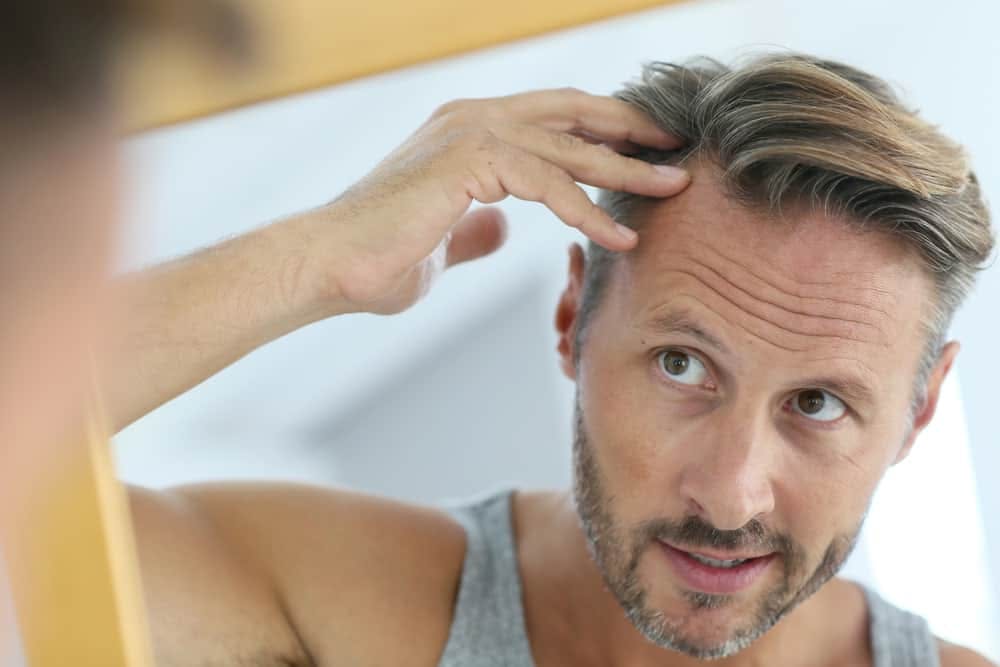If you suffer from severe hair loss it’s tempting to turn to a medication that’s scientifically proven to be effective, rather than trying a more time-consuming approach to see what works best for you. It’s important to realize, however, that some of the most common hair loss treatments—like Propecia—can result in unintended side effects. Let’s take a look at some of the most common Propecia side-effects, then offer some alternatives.
Propecia Side Effects Caused by Some Hair Loss Medications
Hair Health
9 Min Read

Get hair, health, and science news delivered right to your inbox.
What is Propecia?
Propecia is the brand name of the drug finasteride which is approved for men and women in treating hair loss. Taken in the form of a pill, finasteride’s effect on the hair was actually discovered by accident. The medication was initially used to treat enlarged prostate glands, also known as benign prostatic hyperplasia (BPH). Scientists discovered that BPH patients who also had hair loss, found their hair growing back after taking finasteride. So researchers began refining the medication and, in 1997, Merck introduced finasteride for hair loss under the name Propecia.
How the Medication Works
To understand how Propecia works, we have to understand why we lose hair. Hair loss results from a ton of different reasons, like stress, hormonal imbalance, disease, a fungal infection, surgery, or side-effects from certain medications. Just about everyone experiences hair loss at some point in their life. In fact, as many as two-thirds of American men start noticing a thinning head of hair by the age of 35. By the time men reach 50, that number grows to 85%.
The main cause of male pattern baldness is a hormone called dihydrotestosterone, or DHT. Some of the hormone testosterone converts into DHT in your body, which can result in a minimization and or even elimination of hair follicles. It goes without saying that fewer hair follicles results in less hair. So, if your body converts testosterone into DHT at a high rate, and you’re sensitive to this hormone, chances are you’re already seeing less hair on your scalp. But not everyone is as sensitive to the hormone’s effects, and not everyone converts testosterone into DHT at the same rate. Like a lot of things, it’s a question of genetics.
Propecia and other hair loss treatments using finasteride (like Proscar), actually work by targeting the enzyme that converts testosterone into DHT in the body. If you can stop the production of this enzyme, called 5 alpha-reductase, you can slow down or prevent the body from creating excess DHT, thus protecting your hair follicles. Since the drugs address a chemical process in the body, rather than the hair follicle, they are generally very effective. But maintaining a balance of testosterone in the body is complicated—if the body has too much or too little, it can have unintended consequences.
What Propecia Side Effects Can I Expect?
When Merck originally disclosed Propecia side effects, many of them had to do with men’s sexual health. But it was later discovered that the pharmaceutical company had not told customers the whole truth. For example, negative side-effects from Propecia can sometimes persist long after you stop using the drug. In fact, more than 1,300 lawsuits have been filed accusing Merck of knowingly concealing some of the damaging effects of the drug.
Propecia received renewed attention recently when President Trump’s longtime doctor, Harold N. Bornstein, revealed that the president takes it to battle male pattern baldness.
But known Propecia side effects are no small matter (even for a sitting president), including:
- Erectile dysfunction
- Loss of libido
- Ejaculatory disorder
- Men over the age of 55 may experience a higher risk of developing an aggressive type of prostate cancer
- Due to the risks the drug carries for an unborn child, pregnant women should not even touch broken or crushed Propecia pills.
But that’s not all—there are other undesirable side-effects too, like swelling in the hands and feet, dizziness, headaches and skin rashes.
Of course, not everyone taking the drug will experience negative side-effects, but the fact that they can persist years after stopping the medication is concerning.
The most recent research comes from a team at Northwestern University which studied 11,909 men who took the drug. The study, published in 2017, found that even though a relatively small amount (1.4%) of participants suffered side effects such as erectile dysfunction, the problem was significant for those who did. Even more concerning, these side effects lasted for more than 3.5 years after they stopping taking the medicine. Overall, 4.5% of the men taking these medications in the study experienced short-term erectile dysfunction.
Natural Alternatives
So you can see why we prefer natural alternatives to chemical drugs containing finasteride. Because a healthy head of hair shouldn’t require risking your sex life. In fact, Nutrafol was created as a natural choice for hair health after one of the founders experienced severe side effects from chemical drugs himself. Nutrafol can help both men and women and contains only natural ingredients and vitamins that work synergistically to promote healthy hair growth from within.
If you’re not sure your hair loss is due to DHT and male pattern baldness, try eliminating other risk factors before taking supplements or medication. Common reasons for hair loss are stress and lack of sleep. You could also lack certain vitamins or nutrients, so make sure you eat a varied diet with sufficient protein and vegetables. Also, make sure you don’t suffer from a scalp infection, and, as always, take care of your mental health as well. A positive attitude will help you deal with stress no matter what.